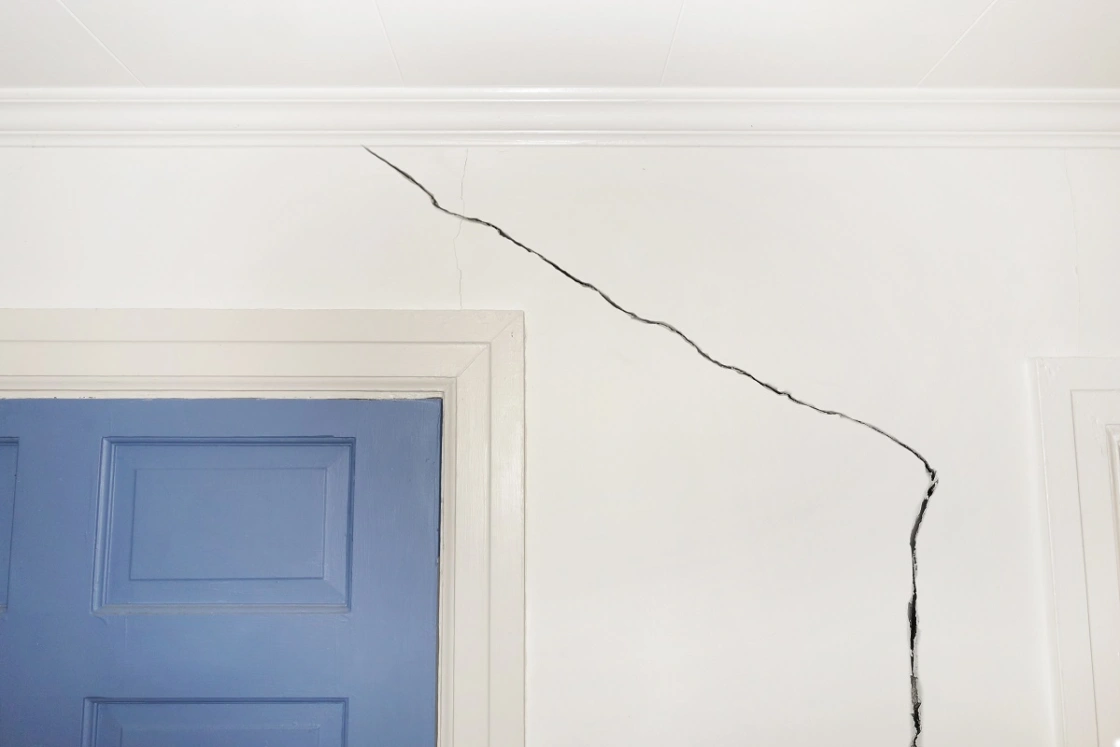9 Signs of Foundation Damage from Water

The only thing worse than foundation damage is the damage it can do to your wallet.
Leaving issues with your home’s foundation unaddressed can lead to costly repairs. As the problems get worse with time, it can even lower the value of your property.
Water is by far one of the most common causes of severe foundation damage, so it helps to have a good understanding of what this kind of damage looks like.
If you want your home to remain standing for decades to come, you’ll need to know its foundation is solid and can go the distance.
Extreme moisture conditions in the soil surrounding your home can rapidly deteriorate its foundation, causing it to shift, buckle, crack, and crumble with time.
The signs discussed below will help you get ahead of water damage to your foundation before it threatens the rest of your home.
We’ll cover both the common and the not-so-common signs of foundation damage from water, so you know what to look for.
In this article:
Signs of Foundation Damage
Attention homeowners! 🏡 Did you know that LeafFilter offers FREE estimates for your gutter protection needs? Say goodbye to clogs and hello to peace of mind with LeafFilter!✅ To learn more and get started today, visit https://t.co/6tWbQ0wMvX #ClogFree #FreeEstimate #LeafFilter pic.twitter.com/9JOuBzi7Mp
— LeafFilter Gutter Protection (@LeafFilter) July 18, 2023
Foundation damage can be sneaky.
After all, you’re dealing with a part of your home that has literally been buried underground, making it much harder to inspect without costly excavation.
Watching for the signs below will help you keep tabs on the health of your home’s foundation without actually digging up your yard.
Shifting Walls, Windows, and Floors

- Sticking windows and doors – Are your bedroom or basement doors constantly getting stuck? Do your windows bind and stick in their frames whenever you try to open them?
Whether you’ve started to notice doors dragging more over time or other similar changes, a shifting foundation is often to blame. Some settling of your foundation over time is to be expected, but significant changes following harsh weather can signal that something more may be happening underground.
- Wandering wallpaper – Water damage to your foundation might not manifest as soggy wallpaper outside of your basement, but it can cause large enough shifts in your home’s structure to loosen wallpaper inside your home.
In particular, pay attention when these signs suddenly appear, seemingly out of nowhere. Any signs of moisture on basement walls should also be a dead giveaway for potential water damage.
- Floor elevation frustrations – If your floors have begun to shift underfoot, then you may be dealing with water-related foundation shifting. As wet soil outside your home pushes against your foundation’s walls, they can bulge and buckle against the immense pressure, impacting the level of your home’s floors and more.
Water in Areas That Get Little Light

- Stains and seepage – Deep stains on your walls, especially in your basement, usually indicate the presence of moisture. If lower portions of your above-ground walls appear wet or discolored, your home may be absorbing more moisture than it can handle.
- Mold and mildew – This sign is one of the easiest to spot and leaves little room for guesswork. Where there is mold, mildew, or a grimy combination of the two, there is bound to be an abundance of moisture. Mold needs plenty of water to grow.
If your walls or floors seem to be attracting mold in spades, then there is good reason to suspect a water drainage issue, and these can quickly cause problems for your foundation.
- Efflorescence – If you can see a white powder forming on the inside of your house’s walls, it might be a form of efflorescence. This happens when water pushes salt particles out of building materials—like concrete—over time and can signal the presence of excess moisture in the soil surrounding your foundation.
Cracks and Gaps Galore

- Cracks in basement walls – Your basement walls shouldn’t show any major signs of deterioration. These are a part of your home’s foundation, and any visible deterioration may imply you have a water-related issue at hand.
If you’ve noticed cracks larger than about ¼ inch wide, it may be time to call in a structural expert for a proper assessment.
- Cracks on the floor – We’ve already mentioned uneven floors as a sign of foundation damage, but outright cracked floors take this issue to a new level. If you have recently noticed new cracks appearing on your floors, your foundation may be seriously compromised.
- Cracks in exposed foundation walls – Cracks in the foundation walls that are visible on your home’s exterior are a sure sign of soil issues at the least, and water issues at the worst.
Soil surrounding your house may have expanded upon taking on rainwater, putting too much pressure on its foundation. If your area hasn’t experienced much seismic activity or severe wind, your problem is probably water.
More specifically, water drainage issues are likely to blame. If your gutters are clogged or your downspouts are short and lack catch basins, your gutter system may be allowing a lot of water to pool around your home, increasing the pressure on your foundation.
Don’t Wait for Water to Damage Your Home
Unwanted water in and around your home can have devastating effects on a building’s foundation when it isn’t properly addressed.
Whether you’re looking to proactively prevent water damage or stop existing issues from getting worse, it’s crucial that you prioritize the way wastewater is caught and conveyed by your drainage systems.
Having gutter guards installed is the first step in protecting your home from water damage.
LeafFilter gutter guards utilize award-winning, patented technology to guarantee your gutters remain clog-free. A stainless steel micromesh ensures only water passes into your gutters, and a perfectly pitched angle helps your gutters shed debris from your roof. Not even shingle grit or pollen can pass through!
You can reach our team through our contact form or give us a call today at 1-800-290-6106 for a free consultation and estimate.
Frequently Asked Questions

How do you test your foundation for water?
You can test your foundation for excess water and leaks by applying water to it, and the soil surrounding it, with a hose outside your home, then checking for signs of seeping, flooding, etc. on the inside.
How often should you soak your foundation?
For anyone living in areas that are subjected to periods of high heat or drought, it may be necessary to actively water the lawn around your foundation a little each day to prevent soil shrinkage from destabilizing them.
If you need to soak or water your foundation to account for dry conditions in your area, you can do so for as little as three times per week for 15 minutes at a time, twice each day.
Can a concrete foundation be water damaged?
Yes, your concrete foundation is susceptible to water damage, especially when wet soil is directly pressing against it. Poor drainage and clogged gutters can worsen this issue, so be sure to watch for indications that it might be happening.
If climbing ladders to clean out your gutters isn’t your idea of a fun time, then LeafFilter’s gutter guards can ensure your gutters remain clog-free. Each professional installation comes with a limited lifetime transferable warranty, so you can stop worrying about your gutters potentially becoming a cause of concern for your foundation.


